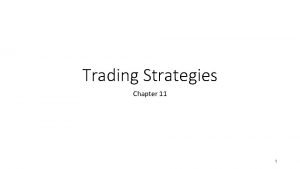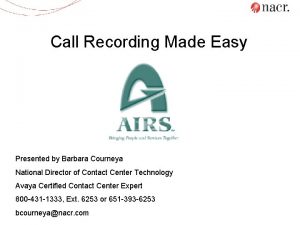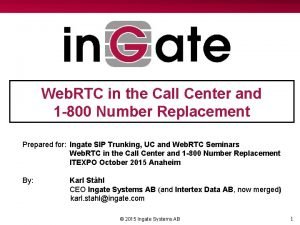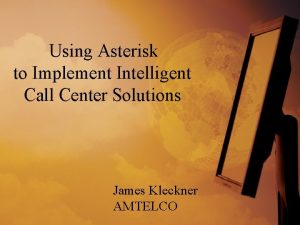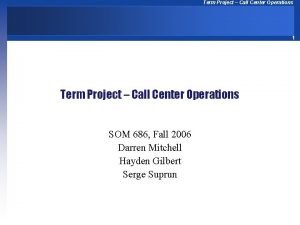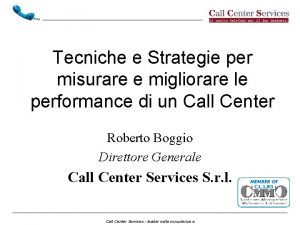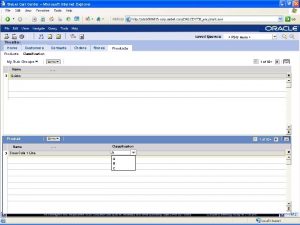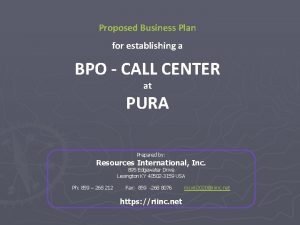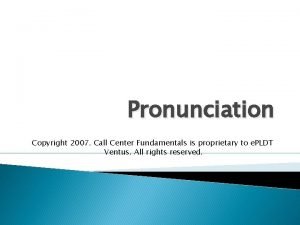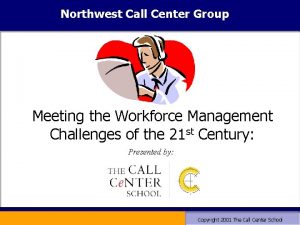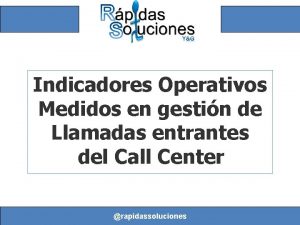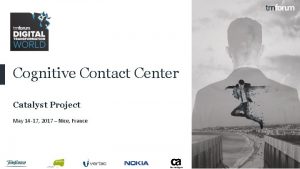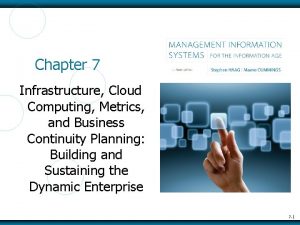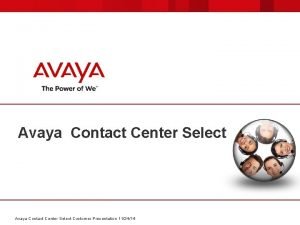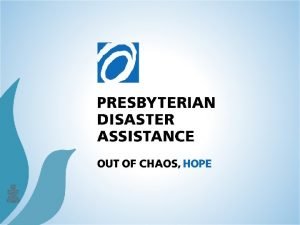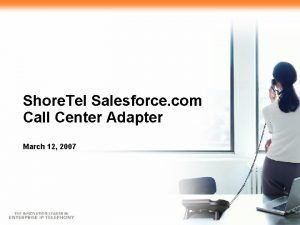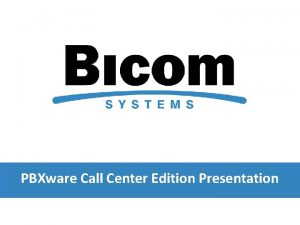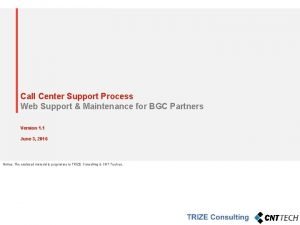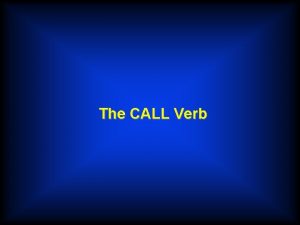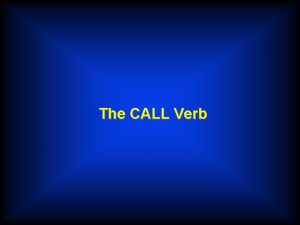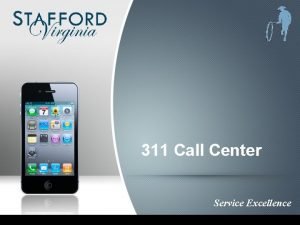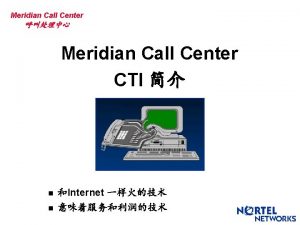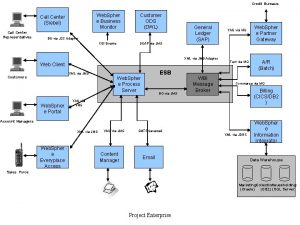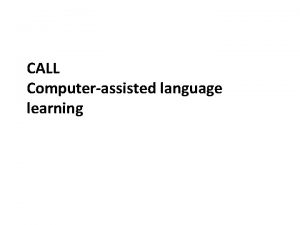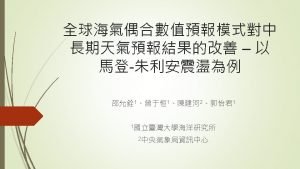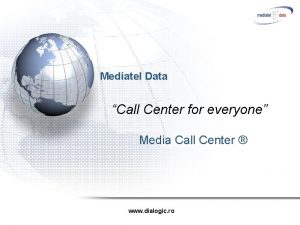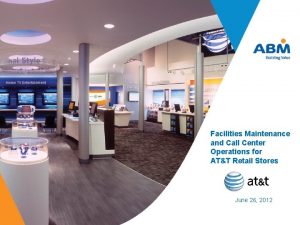Term Project Call Center Operations 1 Term Project




















- Slides: 20

Term Project – Call Center Operations 1 Term Project – Call Center Operations SOM 686, Fall 2006 Darren Mitchell Hayden Gilbert Serge Suprun

Term Project – Call Center Operations Agenda 2 q q q q q Overview Call Center Statistics (October), Definitions & Forecast Process View of the Call Center Competencies, Architecture, Three Key Measures & Little’s Law Call Center Flow, Delays, Queues & Process Attributes Flow Rate-related Measures of Call Center Capacity Flow Time-related Measures of Customer Delay Inventory-related Measures of Customer Queues Performance Improvements & Managing Capacity

Term Project – Call Center Operations Overview 3 Time Warner Cable Los Angeles – Bought Adelphia – Exchanged properties with Comcast – Now provides cable, internet & telephone services to over 2 million customers. q Time Warner Advanced support is local – Teamed up with outsourced partner to provide basic support for all three products. q Basic support includes: billing, basic repair, changes to the accounts & general questions. q Outsourced partner provides basic support from 3 call center locations: USA, Canada & Argentina. q

Term Project – Call Center Operations Overview 4 q q q Call Center in Argentina supports English & Spanish-speaking customers. There are 36 agents employed in the center – 12 are Spanish only – 24 are bilingual On average, the call center handles 40, 000 calls per month. However, over last 2 months handled calls were 36. 5% over forecast. Service level suffered over past 2 months too – In October, only 32. 4% of calls were answered within appropriate time limit.

Term Project – Call Center Operations Call Center Statistics (October) and Definitions 5 DATE FCAST NCO % O/U FCAST ABA SVL% ABA% ASA (Seconds) Hold (seconds) Hand (seconds) 10/1/2006 952 1, 385 45. 5% 595 12. 9% 43. 0% 664 82 510 10/2/2006 1, 473 1, 877 27. 4% 560 14. 0% 29. 8% 481 90 500 10/3/2006 1, 362 1, 688 23. 9% 241 31. 8% 14. 3% 205 86 489 ************ ************ ************ ************ ************ ************ ************ ************ 10/30/2006 1, 473 2, 008 36. 3% 386 38. 1% 19. 2% 285 75 476 10/31/2006 1, 263 2, 237 77. 1% 238 46. 5% 10. 6% 156 73 447 41, 168 54, 494 32. 4% 11, 118 37. 7% 20. 4% 241 74 462 q q q NCO – number of calls offered ABA – number of calls abandoned; ABA% - percentage of calls abandoned SVL – service level ASA – average speed of answer Hand – average handle time

Term Project – Call Center Operations Forecast 6 Past 2 months, Argentina used naïve forecast: – (Based on the last year historical data) – Forecast didn’t take into the account recent product changes & integration projects – As a result October call volume was 32. 4% over forecast. q We are suggesting to use Moving average forecast. q Ex: q MA 103 = (A 10+ A 9+ A 8)/3, using last months data is (54, 494+56, 221+50, 221)/3=53, 636 q Therefore, F 11=53, 636. November forecast should be for 53, 636 calls. This would allow Argentina to staff appropriately.

Term Project – Call Center Operations Process View of the Call Center 7 Process Inputs q q q Outputs Inputs/Outputs – customers calling for service/customers completed the call Flow Units – customers Network of Activities and Buffers – answering customers’ calls Resources – customer service agents (CSA), phone automated system (PAS), etc. Information Structure – account management system, reference materials, etc.

Term Project – Call Center Operations Call Center Competencies and Architecture 8 4 Dimensions for measuring the competence of the call center: – Process Cost – Process Flow Time – Process Flexibility – Process Quality. q Argentina call center focuses on the low cost. – Call center provides high-quality Spanish support. q Argentina call center process architecture is defined by the types of resources (CSA, PAS, etc). – Call center falls somewhere along the spectrum between two extremes (flow shop and job shop). – Flow shop fits better, as call center uses specialized resources that perform limited tasks & produce large volumes with high precision and speed. q

Term Project – Call Center Operations Three Key Call Center Measures 9 Flow Time = Time Customer spends: – In automated phone system – Waiting in the queue for an agent – Talking to an agent. Ex: October Average PAS time is 46, Queue average waiting time is 32 & handle time is 462 seconds. T=540 seconds q Flow Rate = Number of customers that flow through a specific point in the call center process per unit of time. q Inventory = Total number of customers present within call center boundaries. Ex: Argentina call center is 24/7 & call patterns are very different. Therefore, to simplify calculations we will use I=27 customers q

Term Project – Call Center Operations Little’s Law 10 Throughput = Average number of customers that flow through the call center per unit of time. q Little’s Law - Average inventory (=) Throughput (x) Average flow time. – I=Rx. T q Ex: We identified: T = 540 seconds (9 min) I = 27 customers. Therefore, R = I/T R = 27/9 R = 3 customers/minute

Term Project – Call Center Operations Call Center Flow, Delays and Queues 11 Capacity Rp = c/Tp Customer Arrival Rate Throughput Ri Customer R = Min (Ri, Rp) Number: Ii + Ip = I Time: Ti + Tp = T In: Queue + Service =Process

Term Project – Call Center Operations Call Center Process Attributes 12 Inflow Rate Ri = Average rate of customer arrivals per unit time. – In the Argentinean call center, Ri = 5 customers/minute Processing Time Tp = Average time required by agent to process the customer. – Tp = 462 (agent) + 46 (PAS) = 508 seconds q c = Number of agents in the resource pool – c = 36 agents in Argentina q Process capacity (Rp) = Total processing rate at which customers are processed by agents in the resource pool. q – Rp = c/Tp or Rp = 36/8. 47 = 4. 25 customers/minute q Buffer capacity (K) = Maximum number of customers that can wait in queue. – K = 120 (there are 10 lines that can hold 12 each at any given time)

Term Project – Call Center Operations Flow Rate-related Measures of Call Center Capacity 13 Throughput rate (R) = Average rate at which customers flow through the call center process – R = min (Ri, Rp) – In our case, Rp is smaller, so R = Rp = 4. 25 q Capacity utilization (ρ) = Average fraction of the resource pool capacity that is occupied in processing customers – ρ = R/Rp – In our case, R = Rp and ρ = 1 q » Our resource pool is constantly busy processing customers. q Safety capacity (Rs) = Excess processing capacity available to handle the customers inflows. – Rs = Rp – Ri – In our case, Rs = 4. 25 – 5 = -0. 75 » All the available capacity is busy processing arrivals.

Term Project – Call Center Operations Flow Time-related Measures of Customer Delay 14 Average waiting time (Ti) = Time that a customer spends in queue. – Ti = 32 seconds. q Average theoretical time = Average processing time of a customer. – Tp = 462 seconds + 46 seconds (automated system) = 508 seconds q Average flow time in the process (T) = Average time that a customer spends waiting in queue & being served – T = Ti + Tp or T – 508 + 32 = 540 seconds or 9 minutes q Flow time efficiency = Proportion of time that a customer spends being served rather than waiting in queue – Tp / T =. 94 q

Term Project – Call Center Operations Inventory-related Measures of Customer Queues 15 q Average queue length = Average number of customers waiting for service – Ii = R x T i – Ii = 4. 25 x 0. 53 = 2. 25 customers waiting for service q Average number of customers in service = Average in-process inventory – Ip = R x T p – Ip = 4. 25 x 8. 47 = 35. 99 customers in service q Average total number of customers in the process – I = I i + Ip – I = 2. 25 + 35. 99 = 38. 24 customers in the process

Term Project – Call Center Operations Call Center Flow, Delays and Queues 16 Capacity Rp = c/Tp Arrival Rate Throughput Customer 5 customers/min Customer 4. 25 customers/min Number: 2. 25 + 35. 99 = 38. 24 Time: 508 + 32 = 540 seconds In: Queue + Service = Process

Term Project – Call Center Operations Performance Improvements 17 The following levers improved process performance: q Decrease variability in customer interarrival & processing times. q Decrease capacity utilization (or increase safety capacity) either by – Decreasing the arrival rate or increasing the unit processing rate – Increasing the number of servers q Synchronize the available capacity with demand.

Term Project – Call Center Operations Managing Capacity 18 q Capacity utilization (ρ = Ri/Rp ) can be reduced by increasing average processing rate (Rp) q In order to increase processing rate (Rp = c/Tp) we recommended decreasing average processing time (Tp) q To achieve a decrease in processing time: – Identified that billing & escalated calls took longer to handle in this call center vs. similar centers. – Thus recommended & implemented 2 separate hour training segments » Billing prorates explanation » How to handle escalated calls

Term Project – Call Center Operations Call Center Statistics (November) 19 DATE FCAST NCO % O/U FCAST ABA SVL% ABA% ASA Hold Hand 11/1/2006 1, 973 2, 093 6. 08% 268 47. 3% 12. 8% 167 66 449 11/2/2006 1, 986 2, 022 1. 81% 266 54. 7% 13. 2% 152 62 425 ************ ************ ************ ************ ************ ************ ************ ************ 11/25/2006 1, 368 1, 513 10. 60% 279 56. 5% 18. 4% 139 48 370 45, 381 47, 832 5. 40% 7, 080 52. 1% 14. 8% 153 58 410 Processing time decreased to 410 seconds – Tp = 410+46 = 456 seconds or 7. 6 minutes q Process capacity Rp = c/Tp or Rp = 36/456 = 4. 74 customers/minute q Result: Capacity Utilization ρ = Ri/Rp or 5/4. 74 = 1. 06 q

Term Project – Call Center Operations 20
 Protective put diagram
Protective put diagram Long call short call
Long call short call +call +recording +call +centers +gartner
+call +recording +call +centers +gartner Contact center webrtc
Contact center webrtc Asterisk based call center software
Asterisk based call center software Call center projects
Call center projects Misurare performance call center
Misurare performance call center Pdq menu
Pdq menu Business plan for bpo company
Business plan for bpo company Call center fundamentals
Call center fundamentals Call center school workforce management
Call center school workforce management Kundenservice definition
Kundenservice definition 7:30 8
7:30 8 Cognitive contact center
Cognitive contact center Cloud computing metrics
Cloud computing metrics Contact center stress
Contact center stress Avaya aura contact center overview ppt
Avaya aura contact center overview ppt What is presbyterian
What is presbyterian Shoretel salesforce
Shoretel salesforce Call center solution presentation
Call center solution presentation Call center escalation process flow
Call center escalation process flow
